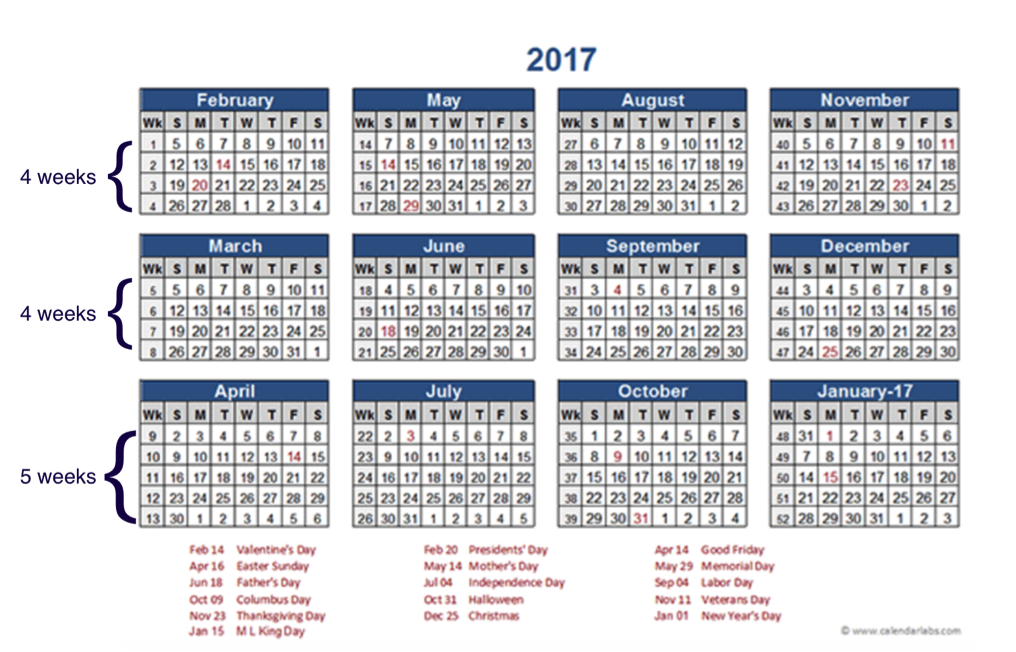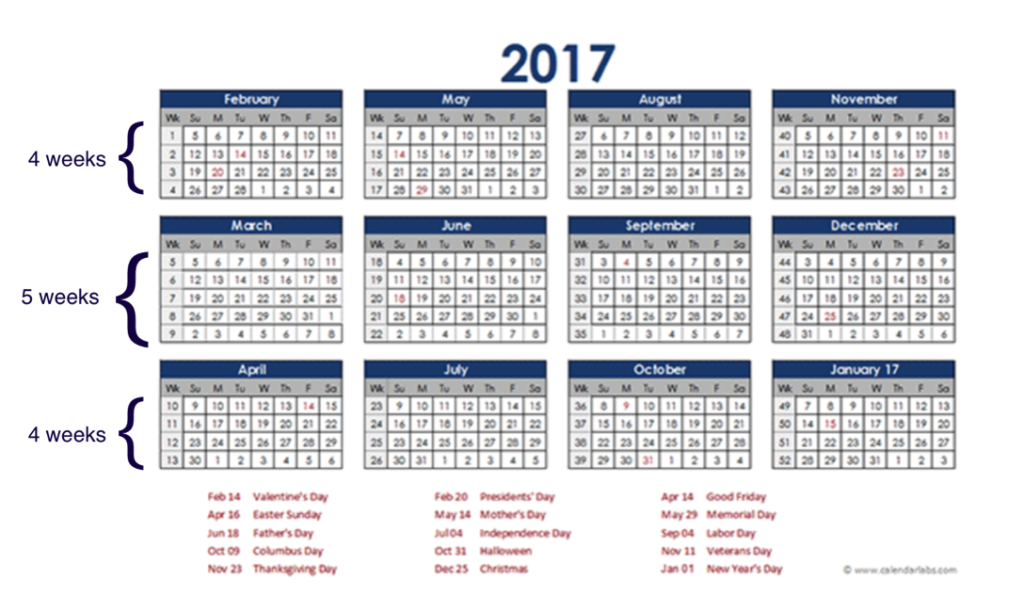Many calendars exist for different purposes, countries, and businesses. The fiscal years for the US and Australia differ, for example, while the calendar year differs from the financial year. For retail companies, there are a few common calendars to use when reporting. In this article, I’ll cover two of the available calendars used by retail companies other than the 12-month calendar.
What is a retail calendar?
Two common retail calendars are the 4-4-5 and 4-5-4 calendars. Detailed descriptions of these two calendars are provided below:
2017 4-4-5 calendar
For the 4-4-5 calendar, each quarter consists of 91 days. The first two months in each quarter consist of 4 weeks, whereas the last month consists of 5 weeks. In addition, the start to each year begins in February instead of January.

Source: http://www.calendarlabs.com/view/2017-retail-accounting-calendar-4-4-5/758
2017 4-5-4 calendar
This calendar is very similar to the 4-4-5 calendar. Each quarter consists of 91 days and the start of each year begins in February instead of January. The difference is that the 1st and 3rd month of each quarter consists of 4 weeks while the 2nd month consists of 5 weeks.

Source: http://www.calendarlabs.com/view/2017-accounting-calendar-4-5-4/760
What is the purpose of a retail calendar?
There are a few advantages and disadvantages to using a retail calendar versus the 12-month calendar. A few advantages includes the following:
- Retail calendars allow you to compare sales across quarters with the same number of days.
- Retail calendars allow you to compare weeks and months in different years with the same week days.
For example, when using the 12-month calendar, January 2016 has five full weekends whereas January 2017 has only 4 full weekends. By using the retail calendar, every month has the same number of weekends and weekdays, which allows you to more accurately compare months from different years. This is useful since typically sales increase during the weekends.
On the other hand, the retail calendar does have a few disadvantages:
- Due to the structure of the retail calendars, each year consists of only 364 days. Thus, every 5 years or so an extra week must be added to the year.
- It’s difficult to compare month–over–month success.
For example, if you try to compare February to March using the 4-5-4 calendar, March would have an advantage since it has 5 weeks of sales compared to February’s 4 weeks of sales.
How can you implement this in Magento BI?
If you and your team use a retail calendar for financial reporting and analyses, you can implement this logic in your RJMetrics account. Since your RJMetrics account uses the 12-month calendar, the first step is to create a CSV file identifying every day with the appropriate retail calendar attributes (like the “retail year”, “retail month”, and so on). For example, February 2017 would have the following attributes when using the 4-5-4 calendar:
| Date | Retail Year | Retail Month | Retail Week | Retail Quarter | Retail Month Name |
| 1/29/17 | 2017 | 1 | 1 | 1 | February |
| 1/30/17 | 2017 | 1 | 1 | 1 | February |
| 1/31/17 | 2017 | 1 | 1 | 1 | February |
| 2/1/17 | 2017 | 1 | 1 | 1 | February |
| 2/2/17 | 2017 | 1 | 1 | 1 | February |
| 2/3/17 | 2017 | 1 | 1 | 1 | February |
| 2/4/17 | 2017 | 1 | 1 | 1 | February |
| 2/5/17 | 2017 | 1 | 2 | 1 | February |
| 2/6/17 | 2017 | 1 | 2 | 1 | February |
| 2/7/17 | 2017 | 1 | 2 | 1 | February |
| 2/8/17 | 2017 | 1 | 2 | 1 | February |
| 2/9/17 | 2017 | 1 | 2 | 1 | February |
| 2/10/17 | 2017 | 1 | 2 | 1 | February |
| 2/11/17 | 2017 | 1 | 2 | 1 | February |
| 2/12/17 | 2017 | 1 | 3 | 1 | February |
| 2/13/17 | 2017 | 1 | 3 | 1 | February |
| 2/14/17 | 2017 | 1 | 3 | 1 | February |
| 2/15/17 | 2017 | 1 | 3 | 1 | February |
| 2/16/17 | 2017 | 1 | 3 | 1 | February |
| 2/17/17 | 2017 | 1 | 3 | 1 | February |
| 2/18/17 | 2017 | 1 | 3 | 1 | February |
| 2/19/17 | 2017 | 1 | 4 | 1 | February |
| 2/20/17 | 2017 | 1 | 4 | 1 | February |
| 2/21/17 | 2017 | 1 | 4 | 1 | February |
| 2/22/17 | 2017 | 1 | 4 | 1 | February |
| 2/23/17 | 2017 | 1 | 4 | 1 | February |
| 2/24/17 | 2017 | 1 | 4 | 1 | February |
| 2/25/17 | 2017 | 1 | 4 | 1 | February |
Please note you are not limited to these attributes. You may also want to analyze the day number of the week (1 through 7) or the week number of the month (1 through 5). This new table in your account will then act as a mapping table for all timestamps. Every timestamp can be assigned the appropriate retail attributes and then reports can be created with this logic
You can check out our Help Center article, “Reporting on a retail calendar“, which provides a 4-5-4 mapping table!
It’s important for your company to be reporting consistently across all departments. If certain departments are using a retail calendar to report numbers and goals, then your other departments should also be reporting with this calendar structure. Reach out to support@rjmetrics.com for help today!
